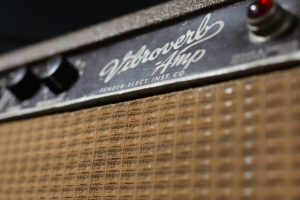As you set out on your journey of learning to play guitar, you will be faced with dozens of decisions, but perhaps the first decision you’ll have to make is what kind of guitar you want to buy.
On the one hand, you’ve probably seen the glamorous and glitzy electric guitars played by rockstars the world over. On the other hand, you can’t miss the subtle beauty of a dreadnought style acoustic with its delicate Mother of Pearl inlays. So, how do you decide between acoustic vs electric when standing inside your local music shop?
Acoustic vs Electric Guitar: A Beginners Guide
Ed Sheeran or Eddie Van Halen?
Before we discuss the differences between acoustic and electric guitars, I feel that it is first important to think about your personal goals and musical interests.
For instance, if you prefer classical guitar or country music, it is natural to gravitate towards an acoustic instrument. Younger people tend to prefer electric guitars for their flashy appeal and the wide range of sounds they can produce.
We need to try and find the best beginner guitar for you and your situation.
There is no right or wrong answer when selecting a beginner guitar, and thousands of talented guitarists have found their way on each side. Just keep in mind that if you’re looking to play grunge rock, an acoustic guitar probably makes little sense for you, and vice versa.
We have a complete guide to finding ‘The Best Kids Guitar’ if you require any further help.
Body Types
The first thing you’ll notice about electric guitar vs acoustic is that they have very different body types.
Most notably, acoustic guitars are known for their large bodies and natural wood finishes, while electric guitars feature slim bodies, usually with interesting cutaways that may or may not serve a purpose for playability.
So you can see the parts of the guitar are very different in every way.
I always recommend that you go try out a wide range of different body styles to see what feels natural to you, but don’t despair if nothing feels quite right just yet.
It does take a while to get your posture perfected, and you will probably feel like some body styles are just too bulky for you. That is totally normal!
However, if you are really struggling to find a good fit, you should know that guitars come in many shapes and sizes.
A Quick Note on Guitar Sizing
Guitar shops are mostly filled to the brim with full-size guitars, but that is not the only option available.
There are half-scale and 3/4-scale guitars as well. These guitars have been scaled down to fit younger learners while maintaining the proper proportions so you can move into a full-scale guitar with proper techniques already established.

The Difference In Sound
Electric
Aside from the distinct looks of an acoustic and electric guitar, they also differ in the way they produce sound.
An electric guitar uses magnetic pickups mounted on the body beneath the strings to pick up the sound of the vibrating strings and send it to the amplifier.
In this case, the amplifier is actually responsible for producing the bulk of the sound that you hear.
Acoustic
By contrast, an acoustic guitar is designed to produce a sound all on its own using the vibrations captured through the soundhole beneath the strings.
Here, it is the construction of the acoustic guitar’s hollow body that is responsible for producing the sound you hear.
Now, you may wonder how an acoustic guitar could produce enough sound to fill an entire concert venue if it doesn’t use an amplifier?
Fear not! Professional acoustic guitar players rely on tiny electric amplifiers built into the hollow body of their guitars. These pickups offer large-scale benefits of amplification without damaging the warm, natural tone that comes from playing acoustically.
For beginners, spending the extra money on an acoustic guitar with a built-in pickup is not strictly necessary, but you can find some affordable options that will give you more flexibility in your playing later on.
Strings
This is a good time to discuss the differences in strings when playing electric or acoustic guitar.
Because an electric guitar uses an amplifier to produce a robust sound, it does not require very large strings.
Notes on a guitar are produced by pressing down on the strings at different intervals, changing the length of the string and the sound it produces.
So, it stands to reason that the lighter weight strings in electric guitars are easier to press than their acoustic counterparts.
If you find that you are struggling to press the strings down to produce clear sound, or if you have small hands, an electric guitar is a great place to start.
With an acoustic, you need much thicker strings to produce a strong enough sound for the body to pick up. As a result, many young players struggle with acoustic guitars until they build up hand strength.
Here is our guide for : What Are Best Acoustic Guitar Strings For Beginners?
Playing Technique
Finding the right fit is the most important part of selecting the right type of guitar for you.
The right fit has a lot to do with your comfort and strength. Yet there are also some differences in playing style. So far, I have focused on how your fretting hand is affected by the guitar you choose, but now we will look at your strumming hand.
Strumming Differences
The arm you strum the strings with rests on the “shoulder” or “body” of the guitar, and your strumming hand sits over the strings.
This will probably feel uncomfortable as you adjust to the edges of the guitar pressing against you. You will become comfortable with practice.
With an electric guitar, the slimmer body style makes it easier to drop your arm over the strings. On an acoustic guitar, you have to prop your arm up at about shoulder height and rest it on the body. From there, you will have to strum across the strings to produce sound.
With an electric guitar, you don’t have to strum too hard because you can artificially change the volume with the help of your amplifier.
On an acoustic guitar, the volume of the sound you produce is entirely dependent on how hard you strum.
For those with short arms or little strength, producing a strong enough sound with an acoustic guitar can be challenging at first.

Don’t Get Distracted
Electric guitars provide many opportunities to get distracted from the music by adding effects, adjusting your amplifier, and dialing in your instrument.
By contrast, the bare-bones nature of the acoustic makes it great for focusing all of your energies on playing technique and perfecting the music itself.
If you feel that you can learn proper playing techniques well on an electric, and you are committed to getting them right, that’s totally up to you.
On the other hand, if you really want to be sure you build technique, and hand strength, an acoustic guitar might be just what you need to keep your practice time distraction-free.
Cost
A final consideration you might want to make is the cost. Both acoustic and electric guitars range from a few hundred dollars up to nearly ten thousand dollars.
For a first-time guitar player, you can expect to spend at least a few hundred dollars to get started, although you might find second-hand guitars cheaper.
However, there may be one downside of starting with an electric guitar. You have to buy the instrument, the amplifier, and the cables to connect it.
Fortunately, there are a few companies like Squier, that offer beginner packages that include a super starter pack that includes everything you need.
This is usually a pretty good bargain for any new player and can save you a lot of headaches trying to build a complete setup. In general, you can find a starter kit for around $200, which is comparable to a low-end acoustic guitar.
On the other hand, if you choose to go with an acoustic, all you really need is the guitar itself. Obviously, you do need to purchase a decent tuner with both acoustic and electric guitars.
But you may choose to buy a strap as well, which will help you hold the guitar up even when you are sitting, but it is not required.
The Verdict: Acoustic Vs Electric Guitar
The question I hear a lot is “should I start with an acoustic or electric guitar?”
Is electric guitar easier than acoustic to learn? No, they’re completely different animals. Two different instruments. Neither is ‘easier’ to learn than the other.
It’s all about personal preference. Hopefully, we’ve helped you more with your decision
For most people and playing styles, the electric guitar is a great beginner option. It is versatile and easy to learn while you’re building hand strength, and more comfortable for new players.
In addition, with the starter packs available today, you can find a complete electric guitar setup at a very affordable price. You can even begin to learn the ins and outs of modifying your guitar sound early on.
If you do prefer a more classical sound, you are always free to start on an acoustic instrument instead. You may find that there is a variety of sizes available.
If you go this route, be sure to consider changing to lighter strings. New guitars generally come with a poor standard of strings attached.
So, give yourself the best chance to succeed when you start and buy some decent strings. Here are some to get you started: ‘Best Acoustic Guitar Strings For Beginners‘
Here’s some valuble tips from the National Guitar Academy if you need further advice.
Let your journey begin!









